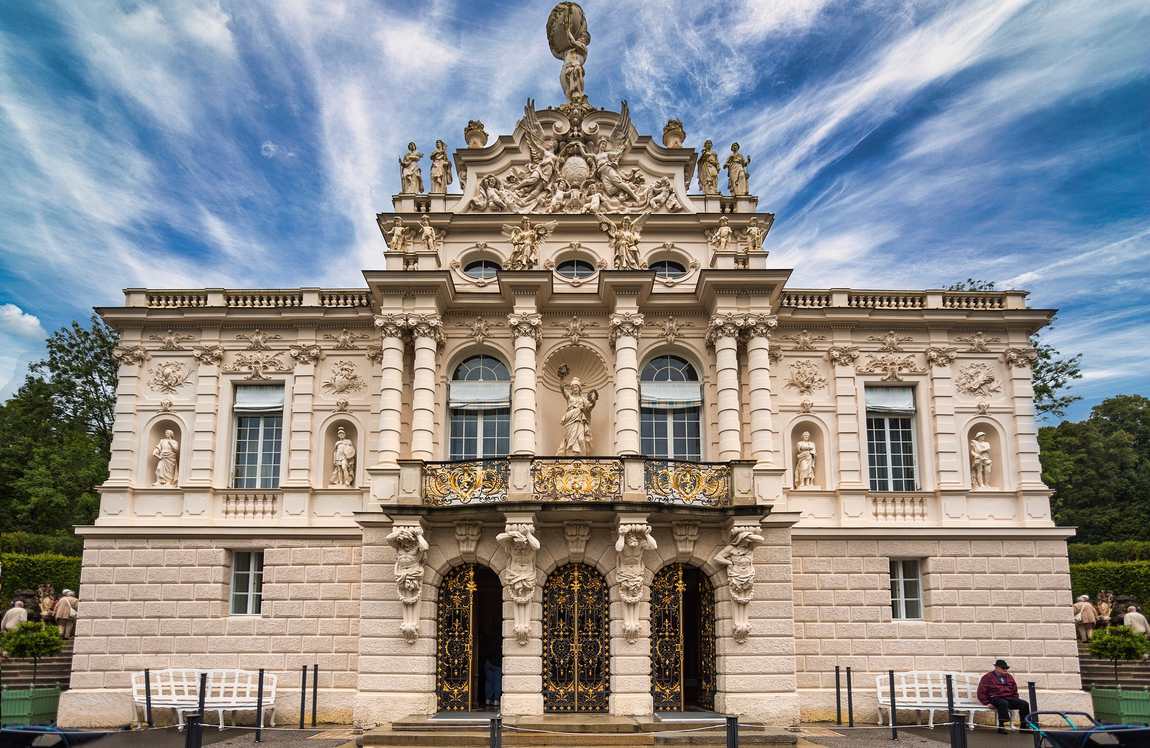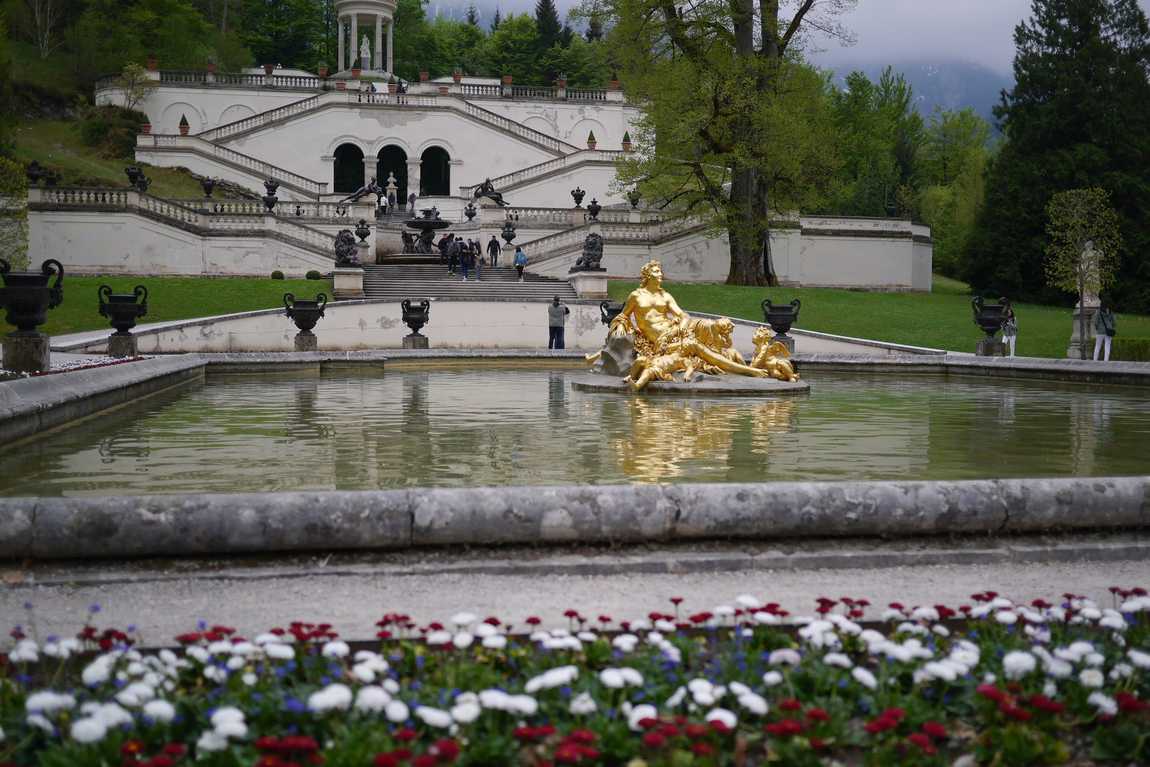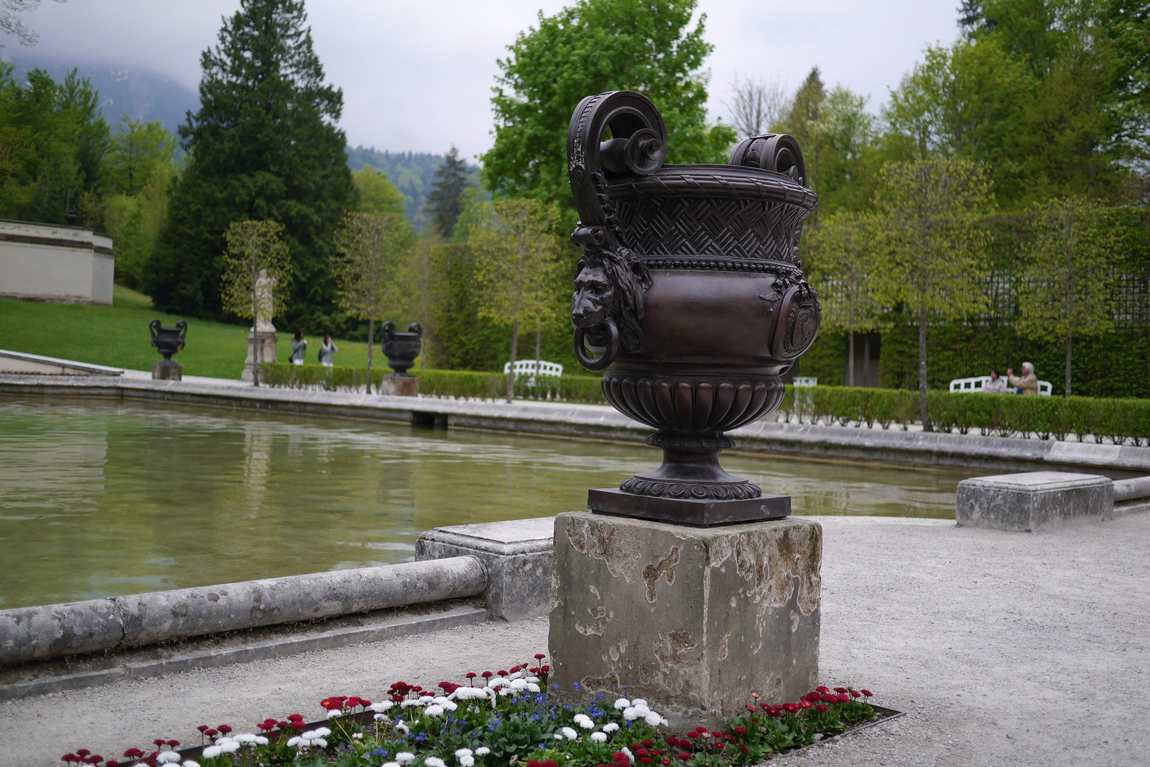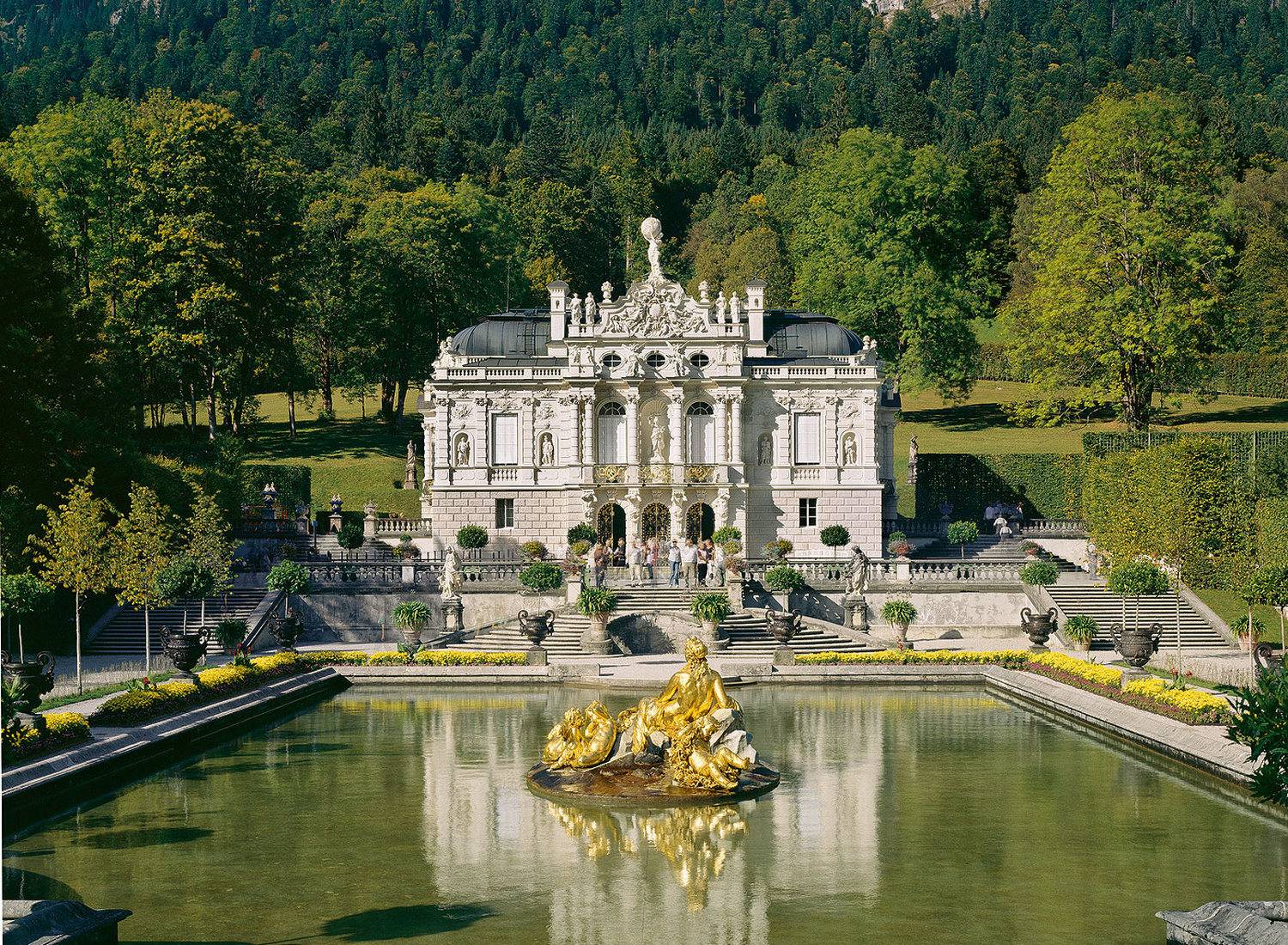Bavarian Linderhof is the miniature 'brainchild' of King Ludwig II, but that did not prevent it from being the monarch's favourite. Ludwig made Linderhof his quiet retreat, where he preferred to escape the light. It is the only palace to have been completed during his reign.
Although Linderhof is not particularly grand and monumental, it has a striking façade and a rich interior. The interiors are a symbiosis of rococo elegance and baroque splendour. The opulence of the halls is dazzling: carvings and mouldings, gold, tapestries, frescoes, crystal, mirrors and porcelain. There is no doubt that Ludwig loved himself.
Contents

Inside the castle there are ten symmetrically arranged halls.
Palace Tour
The large halls — Reception, East Tapestry, West Tapestry, Dining Room and Bedroom — are separated by four offices, also named: Lilac, Yellow, Blue and Pink. The interior of the bedroom, which measures 100 square metres and has 7-metre high ceilings, is finished in rich blue and gold tones.

Bedroom
The king's bedroom is a surprisingly large compared to other rooms and halls. The back of the room is surrounded by a carved balustrade. The splendour unfolding here could not be greater. In the centre, under a canopy, stands a gigantic catafalque-like bed, symbolic of Ludwig's blue colour. Above, in the finest needlework — embroidered with threads of different colours giving the impression of a painting — is his coat of arms. The bedroom is crowned by a monumental candelabra with 108 candles and an artificial waterfall that acts as an air conditioner on hot summer days.
Other features include paintings above the doors. They depict scenes from the life of the French court: the levée of Louis XIV, the wedding of the Dauphin in the Hall of Mirrors at Versailles, the couchée (evening reception) and the merry-go-round in the park at Versailles.
Lilac Cabinet
Adjoining the bedroom is a Cabinet with furniture and walls upholstered in lilac silk. The decoration is almost identical to the Yellow Cabinet, including the pastel portraits.
Yellow Cabinet
Yellow wall coverings and ornamental panels dominate this room. Only this room has carved, moulded and embroidered ornaments in silver. The rest of the surfaces are light blue, creating a cool, elegant trio of colours.
Pink Cabinet
The east wing has the same layout as the west wing. After the bedroom you can find another small room in the shape of a horseshoe. This was the royal dressing room.
The fabrics on the walls and chairs are all pink. The oval pastels in the centre of the wall panels depict members of the Versailles court.
Blue Cabinet
The fourth of the small cabinets is decorated with gilded carvings and mouldings combined with a blue silk finish. The pastels on the wall panels depict personalities from the French court during the reign of Louis XV.
Audience Room
The Audience Hall contains numerous emblems of Ludwig II and references to the French court. Of course, the lonely king never received legates in this relatively small room, so the Audience Hall was also used as an office.
This explains the somewhat unexpected placement of the gilded bronze table under the canopy, which suggests a significant dual function of the room: it refers to both the throne and the reading room. This was precisely what Ludwig had in mind, since he did not see himself as an active, reigning king, but aspired to an ideal reign in the manner of Louis XIV.
The French absolutist kings through whom Ludwig legitimised his concept of monarchy are present in many ways, most notably in the two equestrian statues of Louis XIV and Louis XV on the Italian marble mantelpieces. A pair of small round tables with malachite tops were a gift to Ludwig II from the Russian Empress Maria Alexandrovna.
Dining Room
This room is most famous for its table, known as the 'Wishing Table', after the table in the Grimm fairy tale 'The Wishing Table, the Gold-Ass and the Cudgel in the Sack'.
A crank mechanism allows the table to be lowered into the kitchen. It is an 18th century French invention that allowed court society to remain unnoticed during amorous dinners.
West Tapestry Room
The Gobelin tapestries that give the room its name are in fact fakes, their large images simply applied to a rough canvas.
The pastoral scenes of love are based on paintings by François Boucher and Antoine Watteau. The unbroken panorama of images transports the viewer to a faraway world of love and harmony, two concepts of great importance to the King.
The ceiling painting shows the union of art and beauty in the figure of Apollo receiving Venus. It is also an allegory of evening, in keeping with the room's western orientation.
The furnishings include a life-size peacock from the Sevres porcelain factory. The rare Aeolodicon pianino, a harmonium in the shape of a piano, is the reason why this room is also known as the Music Room.
Another popular tourist destination, Oberammergau Village, is 14 kilometers from the palace
East Tapestry Room
Note in this room the decorative symbolism referring to the sunrise and morning, check out the artwork all dedicated to the ancient gods frolicking on earth.
The fake tapestries depict scenes from Ovid's Metamorphoses: "Diana and Endymion", "Boreas Abducting Oritia", "The Triumph of Bacchus" and "Europa Riding the Bull".
Hall of Mirrors (end of the tour)
King Ludwig himself used this room as a drawing room and was known to read extensively. The King was known as a 'night owl' and often read at night, so one can imagine how bright this room would have been in the light of the many candles.
The Hall of Mirrors, almost entirely covered in mirrors, was inspired by a room in the Munich Residence created by the decorative designer François de Cuvillier. He deliberately designed the room so that no matter which way you looked, there was always another stunning reflection.
Children love to wander through the opulent rooms of Linderhof and listen to stories about the lives of illustrious characters.
Linderhof Park

The Venus Grotto is of particular interest to visitors of all ages. It is always full of curious tourists. This man-made cave, with a ceiling height of over ten metres, has been the setting for some of the most interesting scenes from Wagner's great operas. The most frequently performed scene in the grotto was Tannhäuser. The lighting system in the grotto is reminiscent of modern colour music. It was used to create lighting effects. The system was powered by one of the first electrical generators in Europe.
This 19th-century engineering marvel is now on display at the Technical Museum in Munich.
The ornate parterre welcomes visitors in front of the main façade of Linderhof. At its centre is a large, beautiful fountain, the bowl of which is decorated with a golden figure of the goddess Flora surrounded by angels. The fountains are perhaps one of the most beautiful parts of the palace grounds, all made with great skill and imagination.

The palace park itself is small — only 58 hectares. However, its landscape incorporates several styles at once: a Baroque garden, an English park and architectural elements in the Italian Renaissance style. The path leading up from the palace leads to terraces separated by a symmetrical staircase. It leads to a circular pavilion with an elegant marble statue of Venus.











